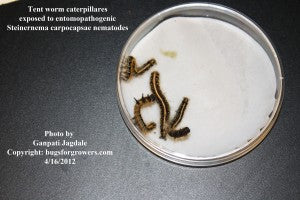Why entomopathoegnic Heterorhabditis indica nematodes should be used to kill small hive beetles?
- They are not harmful to honeybees and honeybee brood but can kill larvae or pupae of honeybee hive insect pest called small hive beetle within 48 hours of application.
- They are commercially available and easy to apply using water cans or traditional knapsack sprayes.
- They are not harmful to children, dogs, cats and personnel involved in its application.
- Since they are exempted by EPA, no special permission need to apply them around honeybee hives against small hive beetles.
How do entomopathogenic nematodes kill small hive beetles?
When the infective juveniles of entomopathogenic nematodes are applied to the soil surface around bee hives, they start searching for their insect hosts such as larvae (grubs) or pupae of small hive beetles that are already present in the soil. Once larva and/or pupa has been located, the nematode infective juveniles penetrate into the body cavity of larva or pupa via
natural openings such as mouth, anus and spiracles (breathing pores). Infective juveniles of
Heterorhabditis nematodes can also enter by puncturing the inter-segmental membranes of the host cuticle. Once in the body cavity, infective juveniles of Steinernematid and Heterorhabditid nematodes release symbiotic bacteria,
Xenorhabdus spp. and
Photorhabdus spp., respectively from their gut in the blood of small hive beetle larva/pupae. In the blood, multiplying nematode-bacterium complex causes septicemia and kill mature larvae and/or pupae of small hive beetles usually within 48 hours after infection. Nematodes feed on multiplying bacteria, mature into adults, reproduce and then emerge as infective juveniles from the small hive beetle larval or pupal cadavers to seek new larvae small hive beetle that are already moved from bee hives in the soil for pupation.









